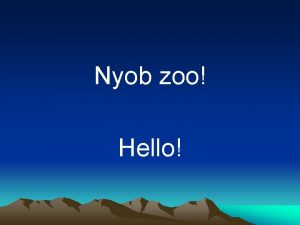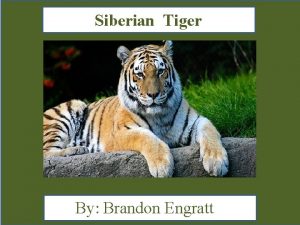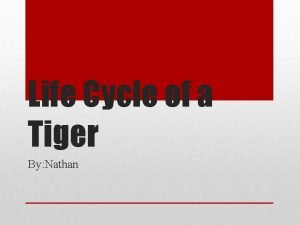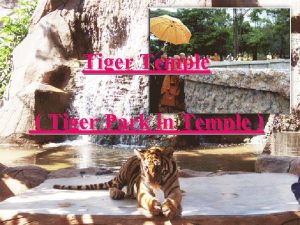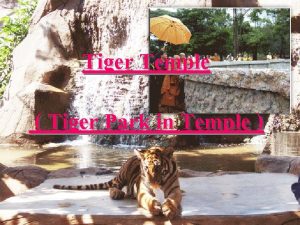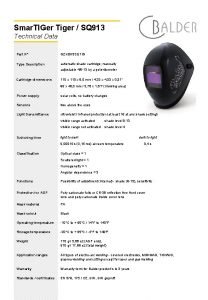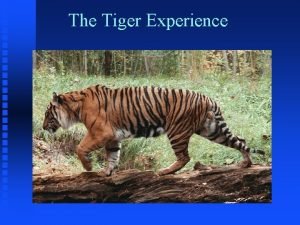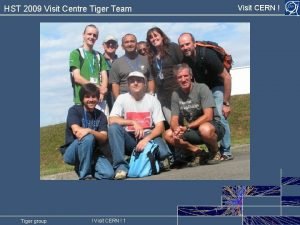A TIGER IN THE ZOO MODULE 2 LESLIE










- Slides: 10

A TIGER IN THE ZOO MODULE 2 LESLIE NORRIS

EXPLANATION STANZA 1 He stalks in his vivid stripes The few steps of his cage, On pads of velvet quiet, In his quiet rage. Here the poet says that the tiger that is confined in the zoo moves a few steps up and down in his cage. He moves quietly on his velvety pads. He is full of rage but is quiet. Here few steps imply that the tiger has been provided with limited space to move in the cage. Then the poet describes the tiger’s appearance. He has prominent stripes all over his body. His paws are as soft as velvet. And because of this the tiger walks silently around the cage. Although the tiger is silent he is angry. This despair and helplessness gets reflected on his face.

STANZA 2 He should be lurking in shadow, Sliding through long grass Near the water hole Where plump deer pass. The poet says that if this tiger was free, he would have been hiding behind the long grass near some the water bodies, in order catch a deer to have it as his food. Basically, the poet wants to say that the actual life of a tiger is to live in jungle where he could catch his prey and eat it but the tiger in the cage cannot do so.

STANZA 3 He should be snarling around houses At the jungle’s edge, Baring his white fangs, his claws, Terrorising the village! The tiger has walked across two states in India. (BBC NEWS DEC. 2019) Here the poet imagines what the tiger would be doing in case he fails to find any prey in his natural habitat. He says that the tiger would be snarling (growling) at the edge of the jungle near some village, showing his white fangs and claws while moving here and there. He would thus become a cause of terror for the villagers. The poet here gives us a hint that if we destroy the natural habitat of tigers( or for that matter any wild animal), they would be forced to turn to our towns and villages to find their food as they have started doing now.

STANZA 4 But he’s locked in a concrete cell, His strength behind bars, Stalking the length of his cage, Ignoring visitors. The poet sees the tiger locked in a concrete cell in the zoo. In spite of all his strength, he is now imprisoned behind the bars. He moves in despair in his cell. He ignores the visitors who prolong his sufferings as they don’t let him rest in the cage. The poet implies the callousness and indifference of the officials towards his pathetic plight.

STANZA 5 He hears the last voice at night, The patrolling cars, And stares with his brilliant eyes At the brilliant stars. The tiger knows no rest during the day because of the visitors. Even at night he remains disturbed due to the noise of the patrolling cars. He keeps staring at the brilliant stars with his brilliant eyes. His eyes are brilliant which implies that he hopes for freedom some day.

MULTIPLE CHOICE QUESTIONS BASED ON THE POEM 1. The poem draws a contrast between _____ and _____. A) animals, human beings C) tiger in a zoo, humans B) tiger in a zoo, tiger in a forest D) humans, tiger in forest 2. What has been personified in the poem? A) tiger B) forest C) zoo D) all of the above 3. How does a tiger feel in a cage. A) Happy B) Contented c)Free D) Angry

4. Where do the tigers hunt the deer? A)in the cage B) near the water hole C) near the cage D) all the above 5. Where should the tiger be snarling? A) At the jungle’s edge above B) at the zoo’s edge C) in the cage D) none of the 6. The ‘last voice’ heard by the tiger is the noise of ………. . A) Villagers B) visitors C) deer D) patrolling cars

EXERCISE FOR PRACTICE Read the poem and : 1. Find the words that describe the movements and actions of the tiger in the cage and in the wild. Arrange them in two columns. 2. Find the words that describe the two places and arrange them in two columns. 3. Notice the use of a word repeated in lines such as these: (i) On pads of velvet quiet. In his rage quiet rage (ii) And stares with his brilliant eyes At the brilliant stars. What do you think is the effect of this repetition?

LIVE AND LET LIVE THANK YOU
 97 nyob zoo sawv ntxov nrog nkauj noog zoo nkauj
97 nyob zoo sawv ntxov nrog nkauj noog zoo nkauj He stalks in his vivid stripes rhyming scheme
He stalks in his vivid stripes rhyming scheme Bengal tiger life cycle of a tiger
Bengal tiger life cycle of a tiger The life cycle of tiger
The life cycle of tiger C device module module 1
C device module module 1 Thể thơ truyền thống
Thể thơ truyền thống Từ ngữ thể hiện lòng nhân hậu
Từ ngữ thể hiện lòng nhân hậu Khi nào hổ mẹ dạy hổ con săn mồi
Khi nào hổ mẹ dạy hổ con săn mồi Diễn thế sinh thái là
Diễn thế sinh thái là Thế nào là hệ số cao nhất
Thế nào là hệ số cao nhất Vẽ hình chiếu vuông góc của vật thể sau
Vẽ hình chiếu vuông góc của vật thể sau
